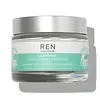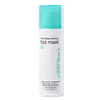What's inside
What's inside
 Key Ingredients
Key Ingredients

 Benefits
Benefits

 Concerns
Concerns

 Ingredients Side-by-side
Ingredients Side-by-side

Water
Skin ConditioningDisiloxane
Skin ConditioningSulfur
AntiseborrhoeicCocamidopropyl Betaine
CleansingKaolin
AbrasiveGlycerin
HumectantPyrus Malus Fruit Extract
Skin ConditioningDisodium Cocoyl Glutamate
CleansingAcacia Senegal Gum
MaskingPolyacrylate-33
Hectorite
AbsorbentButylene Glycol
HumectantZingiber Officinale Root Oil
MaskingQuartz
AbrasiveLecithin
EmollientCaprylic/Capric Triglyceride
MaskingTocopherol
AntioxidantRosmarinus Officinalis Leaf Oil
MaskingCurcuma Longa Root Extract
MaskingEucalyptus Globulus Leaf Oil
PerfumingCitrus Reticulata Leaf Oil
MaskingThymus Vulgaris Leaf Oil
AntimicrobialSalvia Sclarea Oil
MaskingMentha Viridis Leaf Oil
AstringentMentha Piperita Oil
MaskingLavandula Angustifolia Oil
MaskingAbies Sibirica Oil
MaskingAniba Rosaeodora Wood Oil
AstringentCymbopogon Nardus Oil
MaskingMelaleuca Alternifolia Leaf Oil
AntioxidantSodium Cocoyl Threoninate
CleansingXanthan Gum
EmulsifyingMicrocrystalline Cellulose
AbsorbentSodium Cocoyl Glutamate
CleansingSodium Citrate
BufferingPentylene Glycol
Skin ConditioningSodium Hydroxide
BufferingEthylhexylglycerin
Skin ConditioningCaprylyl Glycol
EmollientTetrasodium Glutamate Diacetate
Phenoxyethanol
PreservativeWater, Disiloxane, Sulfur, Cocamidopropyl Betaine, Kaolin, Glycerin, Pyrus Malus Fruit Extract, Disodium Cocoyl Glutamate, Acacia Senegal Gum, Polyacrylate-33, Hectorite, Butylene Glycol, Zingiber Officinale Root Oil, Quartz, Lecithin, Caprylic/Capric Triglyceride, Tocopherol, Rosmarinus Officinalis Leaf Oil, Curcuma Longa Root Extract, Eucalyptus Globulus Leaf Oil, Citrus Reticulata Leaf Oil, Thymus Vulgaris Leaf Oil, Salvia Sclarea Oil, Mentha Viridis Leaf Oil, Mentha Piperita Oil, Lavandula Angustifolia Oil, Abies Sibirica Oil, Aniba Rosaeodora Wood Oil, Cymbopogon Nardus Oil, Melaleuca Alternifolia Leaf Oil, Sodium Cocoyl Threoninate, Xanthan Gum, Microcrystalline Cellulose, Sodium Cocoyl Glutamate, Sodium Citrate, Pentylene Glycol, Sodium Hydroxide, Ethylhexylglycerin, Caprylyl Glycol, Tetrasodium Glutamate Diacetate, Phenoxyethanol
Ingredients Explained
These ingredients are found in both products.
Ingredients higher up in an ingredient list are typically present in a larger amount.
Kaolin is a clay. It is used for oil control and to help minimize pores. Like other clays, kaolin has the ability to absorb excess sebum or oil. This can help clean out pores and mattify the skin.
Some types of kaolin may have exfoliating properties. When water is added to kaolin, it becomes a paste with small abrasive particles.
Most kaolin is a white color, but may be pink/orange/red depending on where it comes from.
The name 'kaolin' comes from a Chinese village named 'Gaoling'. Kaolin clay comes from rocks rich in kaolinite. Kaolinite, the mineral, has a silicate layered structure. Kaolinite is formed from chemical weathering of aluminum siilicate minerals.
Besides skincare, kaolin is commonly used to make glossy paper, in ceramics, toothpaste, and as medicine to soothe stomach issues.
Learn more about KaolinLavandula Angustifolia Oil is more commonly known as lavender essential oil. It is considered a fragrancing ingredient.
Lavender imparts a famous scent. While the smell is lovely, this ingredient and may sensitize skin in topical products. This is because about 85% of the oil is made up of linalool and linalyl acetate.
When exposed to air, these two compounds become strong allergens. This ingredient exhibits cytotoxicity at low concentrations; amounts of 0.25% have been shown to damage skin cells.
A study from Japan found this ingredient caused lavender sensitivity after widespread exposure.
Lavender essential oil has some antimicrobial, antibacterial, and anti-inflammatory properties. However, the cons of this ingredient may outweight the pros.
More research is needed to confirm lavender essential oil's effects when used in aromatherapy.
Lavandula Angustifolia is known as the English Lavender and famous for creating purple fields in Provence, France.
Learn more about Lavandula Angustifolia OilPhenoxyethanol is a preservative that has germicide, antimicrobial, and aromatic properties. Studies show that phenoxyethanol can prevent microbial growth. By itself, it has a scent that is similar to that of a rose.
It's often used in formulations along with Caprylyl Glycol to preserve the shelf life of products.
Water. It's the most common cosmetic ingredient of all. You'll usually see it at the top of ingredient lists, meaning that it makes up the largest part of the product.
So why is it so popular? Water most often acts as a solvent - this means that it helps dissolve other ingredients into the formulation.
You'll also recognize water as that liquid we all need to stay alive. If you see this, drink a glass of water. Stay hydrated!
Learn more about Water